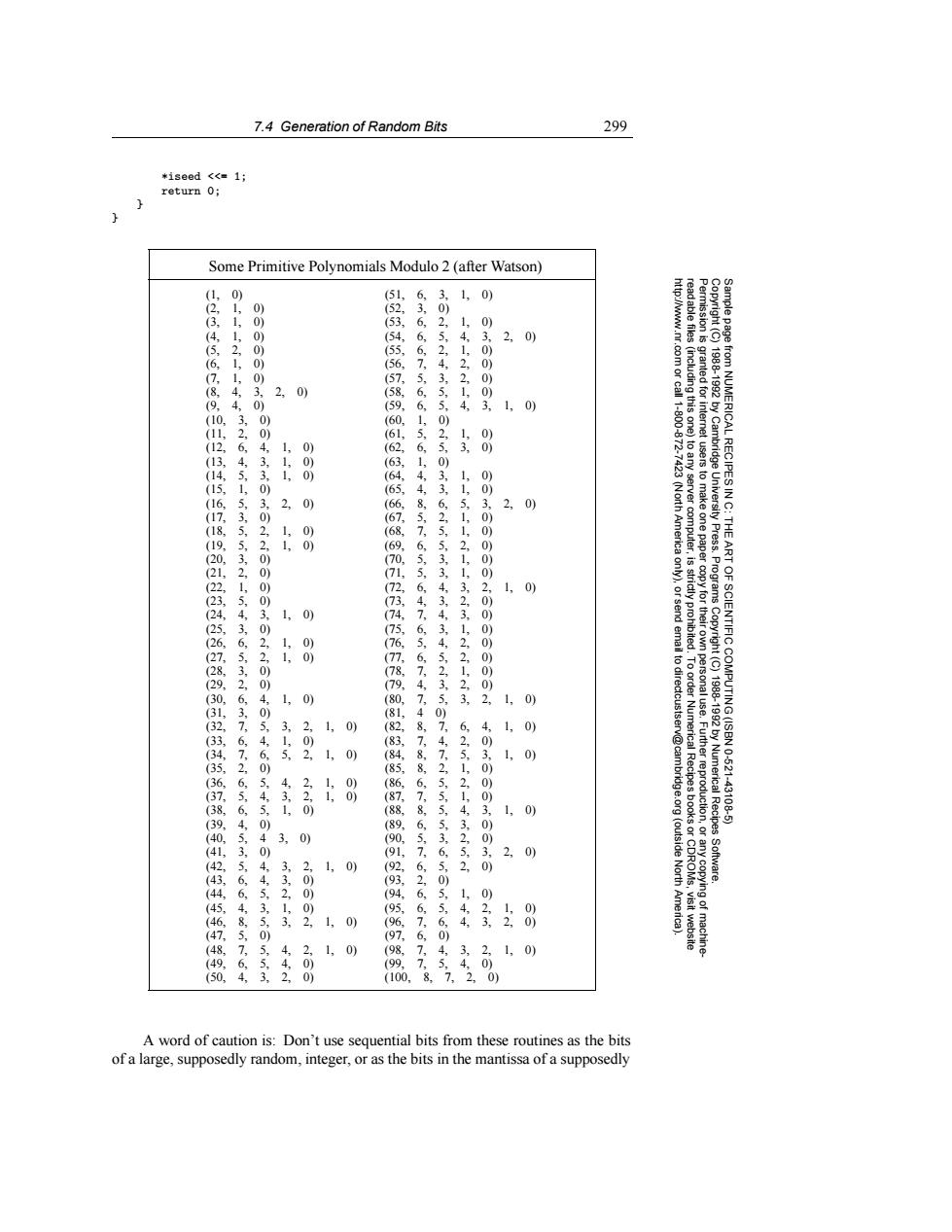正在加载图片...

7.4 Generation of Random Bits 299 *iseed <<1; return 0; Some Primitive Polynomials Modulo 2(after Watson) 1, 9 1, Permission is 0300003 0) 42665医28快1俱1111佳1115低1门保假队江边医队医衡团保镇健糕队区医团健 00000030004330302200003011004034603450404453.0653 2, 0 412214 9 0111211443264515855321543653263767265645356648576 0 00 0 . 00 6366675661561448576556476567474878867865762667677 25243550250336255334343452350747255553650556045 00 3 1151-211323122123 030000020000000工 1, 1、 http://w.nr.com or call 1-800-872-7423(North America only),orsend email to directcustserv@cambridge.org (outside North America) granted for internet users to make one paper copy for their Copyright (C)1988-1992 by Cambridge University Press.Programs Copyright(C)1988-1992 by Numerical Recipes Software. Sample page from NUMERICAL RECIPES IN C:THE ART OF SCIENTIFIC COMPUTING(ISBN 0-521-43108-5) 0) 脱版队 1, 3.5 202 0 0 9 43 220 8 (88 1 (89 91(1410814616日 3 62512143252 40300030030 9 0) (92 33213 2000220 95 1, 0) L44 023 0 442 2, 9 (49, (99, 4 (50. (100 2, 0) A word of caution is:Don't use sequential bits from these routines as the bits of a large,supposedly random,integer,or as the bits in the mantissa of a supposedly7.4 Generation of Random Bits 299 Permission is granted for internet users to make one paper copy for their own personal use. Further reproduction, or any copyin Copyright (C) 1988-1992 by Cambridge University Press. Programs Copyright (C) 1988-1992 by Numerical Recipes Software. Sample page from NUMERICAL RECIPES IN C: THE ART OF SCIENTIFIC COMPUTING (ISBN 0-521-43108-5) g of machinereadable files (including this one) to any server computer, is strictly prohibited. To order Numerical Recipes books or CDROMs, visit website http://www.nr.com or call 1-800-872-7423 (North America only), or send email to directcustserv@cambridge.org (outside North America). *iseed <<= 1; return 0; } } Some Primitive Polynomials Modulo 2 (after Watson) (1, 0) (51, 6, 3, 1, 0) (2, 1, 0) (52, 3, 0) (3, 1, 0) (53, 6, 2, 1, 0) (4, 1, 0) (54, 6, 5, 4, 3, 2, 0) (5, 2, 0) (55, 6, 2, 1, 0) (6, 1, 0) (56, 7, 4, 2, 0) (7, 1, 0) (57, 5, 3, 2, 0) (8, 4, 3, 2, 0) (58, 6, 5, 1, 0) (9, 4, 0) (59, 6, 5, 4, 3, 1, 0) (10, 3, 0) (60, 1, 0) (11, 2, 0) (61, 5, 2, 1, 0) (12, 6, 4, 1, 0) (62, 6, 5, 3, 0) (13, 4, 3, 1, 0) (63, 1, 0) (14, 5, 3, 1, 0) (64, 4, 3, 1, 0) (15, 1, 0) (65, 4, 3, 1, 0) (16, 5, 3, 2, 0) (66, 8, 6, 5, 3, 2, 0) (17, 3, 0) (67, 5, 2, 1, 0) (18, 5, 2, 1, 0) (68, 7, 5, 1, 0) (19, 5, 2, 1, 0) (69, 6, 5, 2, 0) (20, 3, 0) (70, 5, 3, 1, 0) (21, 2, 0) (71, 5, 3, 1, 0) (22, 1, 0) (72, 6, 4, 3, 2, 1, 0) (23, 5, 0) (73, 4, 3, 2, 0) (24, 4, 3, 1, 0) (74, 7, 4, 3, 0) (25, 3, 0) (75, 6, 3, 1, 0) (26, 6, 2, 1, 0) (76, 5, 4, 2, 0) (27, 5, 2, 1, 0) (77, 6, 5, 2, 0) (28, 3, 0) (78, 7, 2, 1, 0) (29, 2, 0) (79, 4, 3, 2, 0) (30, 6, 4, 1, 0) (80, 7, 5, 3, 2, 1, 0) (31, 3, 0) (81, 4 0) (32, 7, 5, 3, 2, 1, 0) (82, 8, 7, 6, 4, 1, 0) (33, 6, 4, 1, 0) (83, 7, 4, 2, 0) (34, 7, 6, 5, 2, 1, 0) (84, 8, 7, 5, 3, 1, 0) (35, 2, 0) (85, 8, 2, 1, 0) (36, 6, 5, 4, 2, 1, 0) (86, 6, 5, 2, 0) (37, 5, 4, 3, 2, 1, 0) (87, 7, 5, 1, 0) (38, 6, 5, 1, 0) (88, 8, 5, 4, 3, 1, 0) (39, 4, 0) (89, 6, 5, 3, 0) (40, 5, 4 3, 0) (90, 5, 3, 2, 0) (41, 3, 0) (91, 7, 6, 5, 3, 2, 0) (42, 5, 4, 3, 2, 1, 0) (92, 6, 5, 2, 0) (43, 6, 4, 3, 0) (93, 2, 0) (44, 6, 5, 2, 0) (94, 6, 5, 1, 0) (45, 4, 3, 1, 0) (95, 6, 5, 4, 2, 1, 0) (46, 8, 5, 3, 2, 1, 0) (96, 7, 6, 4, 3, 2, 0) (47, 5, 0) (97, 6, 0) (48, 7, 5, 4, 2, 1, 0) (98, 7, 4, 3, 2, 1, 0) (49, 6, 5, 4, 0) (99, 7, 5, 4, 0) (50, 4, 3, 2, 0) (100, 8, 7, 2, 0) A word of caution is: Don’t use sequential bits from these routines as the bits of a large, supposedly random, integer, or as the bits in the mantissa of a supposedly